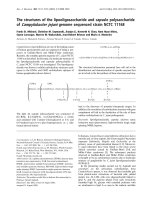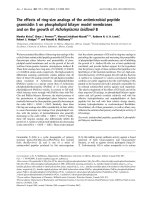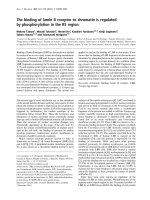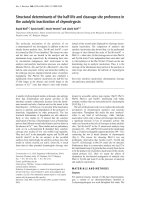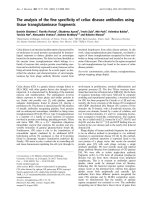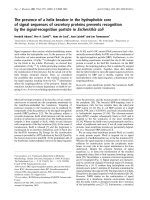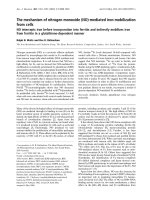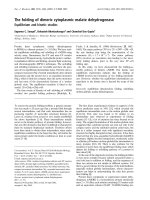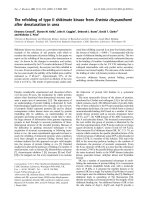Báo cáo y học: "The determinants of susceptibility/resistance to adjuvant arthritis in rats" ppt
Bạn đang xem bản rút gọn của tài liệu. Xem và tải ngay bản đầy đủ của tài liệu tại đây (83.37 KB, 9 trang )
Available online />Page 1 of 9
(page number not for citation purposes)
Abstract
Adjuvant arthritis (AA) serves as an excellent model for human
rheumatoid arthritis. AA is readily inducible in certain rat strains, but
not in others. Susceptibility/resistance to AA is determined by
multiple factors. Among the genetic factors, both MHC and non-
MHC genes contribute to arthritis susceptibility, and specific
quantitative trait loci show association with the severity of the
disease. Differential T-cell proliferative and cytokine responses, as
well as antibody responses, to heat-shock proteins are evident
when comparing AA-susceptible and AA-resistant rats. In addition,
neuroendocrine factors and the housing environment can further
modulate arthritis susceptibility/severity in particular rat strains.
Introduction
Adjuvant arthritis (AA) is inducible in susceptible rat strains,
such as the Lewis (LEW) rat, by a single subcutaneous
injection of heat-killed Mycobacterium tuberculosis H37Ra
(Mtb) in oil. AA has been used extensively as an animal
model of human rheumatoid arthritis (RA) for studies on the
disease pathogenesis and for testing of new products for
their therapeutic efficacy [1]. Various outbred and inbred rat
strains differ in their relative susceptibility to AA (Table 1).
Similarly, the prevalence of RA differs significantly among
human populations living in different geographical regions
of the world, and even among subpopulations within the
same region [2]. Conducting well-controlled studies to
unravel the mechanisms underlying the disease
susceptibility in RA, however, is difficult for multiple reasons
– including the genetic heterogeneity of human populations
and the differences in the environmental influences. In this
regard, studies in animal models of arthritis serve an
invaluable purpose by providing information that is directly
relevant to human RA.
In the past 10 to 15 years, significant advances have been
made in unraveling the mechanisms involved in the initiation
of AA as well as the regulation of AA. Studies comparing the
physiological characteristics as well as the immune
responsiveness of AA-susceptible rat strains versus AA-
resistant rat strains have provided critical insights into the
disease process and have thereby contributed to these
advancements. In the present review we highlight the major
factors determining the susceptibility/resistance to AA
(Table 2). In a few places, studies from other models of
arthritis are also included.
The differential susceptibility to AA of inbred rat strains
bearing different MHC haplotypes (for example, LEW rats
and Brown Norway (BN) rats) as well as those possessing
the same MHC haplotype but having disparate non-MHC
(background) genes (for example, LEW rats and Wistar–
Kyoto (WKY) rats) (Table 1) underscores the significance of
genetic factors in determining susceptibility/resistance to AA.
These genetic factors mediate their effect in part via
influencing the quantitative and qualitative aspects of immune
response to the disease-related antigens (Table 2). Super-
imposed on this genetic predisposition is the modulation of
disease susceptibility by hypothalamic–pituitary–adrenal
(HPA) axis activity and microbial agents.
Genetic linkage studies for adjuvant
arthritis-linked quantitative trait loci
Studies in experimental models have identified many quanti-
tative trait loci (QTLs) that show a significant association with
arthritis susceptibility and severity [3-6]. At least 52 QTLs
have been identified in different rat models of arthritis, and
these QTLs cover approximately 54% of the total rat genome
Review
The determinants of susceptibility/resistance to adjuvant
arthritis in rats
Eugene Y Kim and Kamal D Moudgil
Department of Microbiology and Immunology, University of Maryland School of Medicine, HH 323C, 660 West Redwood Street, Baltimore,
MD 21201, USA
Corresponding author: Kamal D Moudgil,
Published: 7 August 2009 Arthritis Research & Therapy 2009, 11:239 (doi:10.1186/ar2755)
This article is online at />© 2009 BioMed Central Ltd
AA = adjuvant arthritis; AO = Albino Oxford; Bhsp65 = mycobacterial heat-shock protein 65; BN = Brown Norway; DA = Dark Agouti; F344 =
Fischer F344; GN = autoimmune glomerulonephritis; HPA = hypothalamic–pituitary–adrenal; hsp = heat-shock protein; IFN = interferon; IL = inter-
leukin; LEW = Lewis; LNC = lymph node cells; MHC = major histocompatibility complex; mRNA = messenger RNA; Mtb = Mycobacterium tuber-
culosis H37Ra; QTL = quantitative trait locus; RA = rheumatoid arthritis; Rhsp65 = rat heat-shock protein 65; ROS = reactive oxygen species; Th1 =
T-helper type 1; TLR = Toll-like receptor; TNF = tumor necrosis factor; WKY = Wistar–Kyoto.
Arthritis Research & Therapy Vol 11 No 4 Kim and Moudgil
Page 2 of 9
(page number not for citation purposes)
[6]. These QTLs are distributed among various chromosomes
(including the X chromosome), except for chromosomes 11,
13 and 17, but at present there is no information about QTLs
on the Y chromosome [6]. Some QTLs on autosomes show
gender preference.
QTLs for one animal model of arthritis (for example, AA)
overlap with and/or show homology with QTLs for other
experimental models of arthritis (for example, collagen-
induced arthritis) as well as for human RA. In addition, QTLs
for arthritis susceptibility overlap with those identified for
several other autoimmune diseases, including experimental
autoimmune encephalomyelitis, insulin-dependent diabetes
mellitus, autoimmune uveitis, lupus, and inflammatory bowel
disease [4,7]. Specific arthritis-related QTLs show a strong
correlation with different phases of the disease (onset, peak,
and recovery) as well as with pathological features of arthritis
(pannus formation, cartilage damage or antigen-specific
antibody levels). The QTLs also include the genes for cyto-
kines and cytokine receptors, antigen processing and presen-
tation, and hormonal balance.
For AA, Aia1 on chromosome 20 and Aia2 and Aia3 on
chromosome 4 show a strong association with arthritis
severity [4,5]. Aia1 includes the rat MHC (RT.1), and two of
the above three loci are common with collagen-induced
arthritis in rats – namely Aia1/Cia1 and Aia3/Cia3 [4,5]. The
QTLs Aia1, Aia2 and Aia3 from AA-resistant Fischer F344
(F344) rats reduce arthritis severity as expected, but
surprisingly Aia4 from F344 rats enhances arthritis severity
when compared with AA-susceptible Dark Agouti (DA) rats.
Aia5 (= Cia5) from F344 rats on chromosome 10 also
reduces AA severity [5]. Some of these loci also show
differential gender influence, affecting either both sexes
(Aia1), or only male (Aia2) or only female (Aia3). Three QTLs
have been reported for oil-induced arthritis (Oia1, Oia2 and
Oia3) [3].
Susceptible strains of rats develop polyarthritis following
injection of pristane (2,6,10,14-tetramethylpentadecane) [8,9].
Studies in the pristane-induced arthritis model have provided
novel insights into the precise functional association of a
genetic locus. In pristane-induced arthritis, the QTL Pia4 has
been narrowed down to one gene (Ncf1), which is part of the
nicotinamide adenine dinucleotide phosphate oxidase com-
plex [9]. The polymorphism of Ncf1 leads to lower oxidative
burst, and rats with this mutated gene develop more severe
arthritis [9]. Increased production of reactive oxygen species
(ROS) has also been implicated in the AA resistance of
Albino Oxford (AO) rats [10].
Table 1
Adjuvant arthritis-susceptible/resistant rat strains
Strain Susceptibility to AA MHC haplotype References
Inbred rats
Lewis
a
+ RT-1
l
[21-24]
Dark Agouti + RT-1
av1
[45]
Piebald Viral Glaxo + RT-1
c
/RT-1
av1
[65]
Brown Norway
b
+/– RT-1
n
[23,33]
Fischer F344
c
+/– RT-1
1vl
[59,60]
Wistar–Kyoto – RT-1
l
[24]
Wistar Albino Glaxo – RT-1
u
[42]
Buffalo – RT-1
b
[41]
Albino Oxford – RT-1
u
[45]
Outbred rats
Sprague Dawley
d
+ – [66]
Holtzman
e
+ – [41]
Wistar
f
+/– – [31,55,56]
MHC, major histocompatibility complex.
a
Generally, male and female rats are comparable in their incidence of and the course of adjuvant arthritis
(AA). In one study, however, higher sensitivity of female rats over male rats for complete Freund’s adjuvant-induced inflammation and hyperalgesia
has been reported [67].
b
Reported to be AA resistant in one study [23], but susceptible (males susceptible with moderate level of severity, but
females resistant) in another study [33].
c
Fischer F344 rats can develop AA when bred and kept in a germ-free or barrier facility, but acquire
resistance when bred and kept in a conventional environment.
d
Outbred rats; males develop AA of much greater severity than female rats.
e
Originally derived from the Sprague Dawley rat.
f
Outbred rats with lines of rats showing susceptibility or resistance to AA.
Although the AA-resistant WKY rats have not been examined
for arthritis-specific QTLs, studies on experimentally-induced
autoimmune glomerulonephritis (GN) in the GN-susceptible
WKY rats versus GN-resistant LEW and DA rats have un-
raveled several genetic loci controlling the disease
susceptibility [11,12]. For example, the susceptibility of WKY
rats to GN has been attributed in part to the low copy number
of the gene Fcgr3 compared with that in the GN-resistant
LEW rats [11]. In the near future, this information might be
relevant for evaluating the results of studies on WKY/LEW
rats for AA susceptibility.
Studies in patients with RA have revealed genetic loci that
have strong association with disease pathogenesis. These
include, for example, the shared epitope, protein tyrosine
phosphatase nonreceptor 22, signal transducer and activator
of transcription 4, and tumor necrosis factor receptor-
associated factor 1-complement component 5 [13-16].
Cell-mediated and humoral immune response
to heat-shock proteins of arthritis-susceptible
versus arthritis-resistant rat strains
AA can be induced by subcutaneous injection of LEW rats
with Mtb in oil [1]. The paw inflammation starts after 8 to
10 days, peaks at about 15 to 16 days, and then undergoes
spontaneous recovery in the subsequent 12 to 15 days
following the arthritogenic challenge. The autoimmune inflam-
mation of paws following Mtb injection is initiated by
infiltration of mononuclear cells, mostly lymphocytes, macro-
phages and monocytes [1,17-20]. Several chemokines, inclu-
ding monocyte chemoattractant protein 1, play an important
role in the pathogenesis of AA [18,19]. Monocyte chemo-
attractant protein 1 induces chemotaxis of monocytes into the
joints, and it is expressed in the synovial tissue and blood
when the clinical disease has progressed significantly [19].
Interestingly, inhibition of monocyte chemoattractant protein 1
after the onset of AA downmodulates the course of AA,
highlighting the significance of the role of this chemokine in
the progression of the disease [19]. For the T cells, the
precise target antigen in AA is not clear, but the heat-shock
protein hsp65 has been invoked in the disease process
[21-24]. Unlike LEW rats, WKY rats are resistant to induction
of AA following Mtb injection [24,25].
T-cell proliferative response to hsp65
Immune responses to mycobacterial heat-shock protein 65
(Bhsp65) play a critical role in the immunopathogenesis of
AA in the LEW rat [21,22,24]. The T-cell response to
Bhsp65 determinant 180 to 188 has been implicated in
disease induction in LEW rats [21]. (Bhsp65 peptide 180 to
188 is cross-reactive with its longer version, Bhsp65 peptide
177–191 [24].) With progression of AA, arthritic LEW rats
raise an immunoregulatory T-cell response to Bhsp65
C-terminal determinants that apparently contributes to
recovery from acute AA [24]. Moreover, these rats
spontaneously develop T-cell responses to (self) rat heat-
shock protein 65 (Rhsp65) and the Rhsp65 C-terminal
determinants, which are protective against AA [26,27]. The
T cells against Bhsp65 C-terminal determinants are cross-
reactive against Rhsp65 C-terminal determinants [27].
Available online />Page 3 of 9
(page number not for citation purposes)
Table 2
Factors affecting susceptibility/resistance to adjuvant arthritis
Effector pathways/response Susceptibility/resistance (+/–) Rat strains tested References
MHC and non-MHC genes including particular quantitative +/– Table 1 Table 1,
trait loci influence arthritis susceptibility [4,5]
Differential T-cell proliferative and/or cytokine response to +/– LEW/WKY/Wistar/F344 [20,24,30,31,
Bhsp65, its arthritogenic epitope 180 to 188, or its regulatory 33,36]
C-terminal determinants
Increased T-cell response to Rhsp65 and its regulatory epitopes – LEW/WKY [20,24,26]
Anti-Bhsp65/Rhsp65 antibody response induced upon Mtb challenge – LEW/BN/WKY/F344/Wistar [23,25,43]
Increased expression of hsp47 in the joints and enhanced + DA/AO [45]
anti-hsp47 antibodies in rats with arthritis
Immune response to hsp71 – DA/AO/LEW [45,46]
Migration into and retention within the target organ (joints) + LEW/WKY [19,20]
of arthritogenic leukocytes; the role of monocyte chemoattractant
protein 1 and monocyte/macrophage chemotaxis
Increased reactive oxygen species contributing to arthritis resistance – DA/AO [10]
Blunted hypothalamic–pituitary–adrenal axis activity + LEW/F344/Wistar [51,53-55]
Microbial flora in a conventional housing environment – F344/Wistar [56,59,60]
Bhsp65, mycobacterial heat-shock protein 65; hsp, heat-shock protein; MHC, major histocompatibility complex; Mtb, Mycobacterium tuberculosis
H37Ra; Rhsp65, rat heat-shock protein 65.
Generally, immune response to self-antigens is believed to
initiate autoimmunity. Studies by other workers [28] and by us
[26,29], however, have shown that immune reactivity to self-
hsp65 is immunoregulatory in the AA model [26] as well as in
patients with juvenile idiopathic arthritis [28]. Immunization of
LEW rats with self-hsp65 affords protection against subse-
quent induction of AA by injection of Mtb in oil [26]. In juvenile
idiopathic arthritis, increased immune response to self-hsp65
correlates with a favorable outcome of the disease [28].
We have compared the arthritis-susceptible LEW rats with
the arthritis-resistant WKY rats that share the same MHC
haplotype (RT.1
l
) [20,24,30]. Following Mtb challenge, both
LEW rats and WKY rats raised comparable levels of recall
T-cell proliferative response to Bhsp65 and its arthritogenic
determinant Bhsp65 peptide 177 to 191/Bhsp65 peptide
180 to 188 [30]. Unlike LEW rats, however, WKY rats raised
a T-cell response to Bhsp65 C-terminal determinants early
after Mtb injection. Moreover, WKY rats gave a higher level of
recall T-cell response to Rhsp65 compared with that of LEW
rats before the appearance of any clinical signs of AA in the
latter [20]. These results suggest that the temporal kinetics of
the appearance of a T-cell response against Rhsp65 and
against Bhsp65 C-terminal determinants/Rhsp65 C-terminal
determinants following Mtb injection is an important
determinant of disease susceptibility in AA.
In a study on Wistar rats, a deficiency in T-cell response to
Bhsp65 upon Mtb injection correlated with protection against
AA [31]. Wistar rats without arthritis gave a significantly
reduced level of T-cell response to Bhsp65 compared with
rats with arthritis, but both rat groups gave a comparable
level of T-cell response to the immunogen Mtb.
Unlike LEW rats, F344 rats are relatively resistant to AA.
Differences in the T-cell repertoire against Bhsp65 and its
arthritogenic determinant Bhsp65 peptide 180 to 188 have
been proposed as one of the reasons for the AA resistance
of F344 rats [32,33]. Furthermore, F344 rats were neither
defective in antigen/epitope processing and presentation
nor displayed active suppression of arthritogenic T-cells in
vitro [33].
Cytokine responses induced by hsp65
New complexities regarding the role of cytokines in the
immunopathogenesis of arthritis as well as other diseases are
emerging as new information about cytokines comes forth
[30,34-36]. AA was shown to be adoptively transferred to
naïve rats by a well-characterized T-cell clone, A2b, which is
a CD4
+
T cell that secretes IFNγ [21,37]. Similarly, Mtb-
primed T cells that can transfer disease are mostly T-helper
type 1 (Th1) [37]. Our studies in AA, however, have revealed
a protective role of IFNγ and TNFα [30,36].
Until recently, most of the available information regarding the
temporal cytokine profiles in arthritic LEW rats pertained to
antigen nonspecific ex vivo cytokine secretion or to cytokine
mRNA levels [38,39]. In our recent studies in AA [30,36], we
observed higher Th1 cytokine levels against Bhsp65 during
the recovery phase compared with those at the onset of or
the peak phase of the disease. The cytokine response to
Rhsp65 was found to be similar to that against Bhsp65 [20].
In general, the cytokine response of T cells against Bhsp65
and Rhsp65 as well as their defined antigenic determinants
consisted predominantly of proinflammatory cytokines, IFNγ
and TNFα. Furthermore, higher levels of proinflammatory cyto-
kine secretion correlated with reduced severity of arthritis.
As AA is a Th1-mediated disease, this observation pointed to
the role of Th1 cytokines in disease regulation. This inference
indeed was supported by the cytokine profiles of Mtb-
immunized, AA-resistant WKY rats. These rats produced high
levels of Th1 cytokines early following Mtb injection, and the
overall shape of the cytokine profiles was almost the opposite
of that of LEW rats when followed against time post Mtb
injection. Furthermore, treatment of LEW rats with TNFα or
with Rhsp65 peptide 465 to 479, which primes a Th1
response, resulted in downmodulation of the clinical course
of AA in LEW rats, albeit employing different mechanisms
[30,36]. The levels as well as the timing of production of Th1
cytokines in response to Bhsp65/Rhsp65 therefore have a
significant influence on the outcome of Mtb challenge of
LEW/WKY rats. Other investigators have reported differ-
ences in the frequency/activity of T-helper type 2-cytokine
secreting cells and CD8
+
suppressor/regulatory T cells in
AA-susceptible rats (LEW rats, Holtzman rats) versus AA-
resistant rats (BN rats, Buffalo rats, and Wistar Albino Glaxo
rats) [40-42].
Two aspects of cytokine function are of significance when
examining the susceptibility/resistance to AA. First, the pro-
inflammatory cytokines (for example, TNFα and IFNγ) are not
always pathogenic; instead, they can be immunoregulatory in
nature [30,36]. Second, the T cells of arthritic LEW rats
specific for the arthritogenic determinant of Bhsp65 (Bhsp65
peptide 180 to 188) produced IL-17 [30]. The contribution of
IL-17 as well as the cytokines regulating IL-17 (for example,
IFNγ, IL-4, and IL-27) in conferring susceptibility/resistance to
AA, however, remains to be determined.
Antibody response to hsp65
AA can be adoptively transferred to naïve syngeneic recipient
rats via the T cells but not the serum antibodies of arthritic rats.
Antibodies per se are therefore not considered arthritogenic in
AA. Studies by other workers and us [23,25], however, have
revealed that antibodies against Bhsp65 and its mammalian
homologue (Rhsp65) are protective in AA, and that the
antibody profiles of AA-susceptible LEW rats are significantly
different from that of AA-resistant BN rats and WKY rats.
In a study on Wistar rats immunized with Mtb, the nonarthritic
subgroup of rats showed much higher antibody response
Arthritis Research & Therapy Vol 11 No 4 Kim and Moudgil
Page 4 of 9
(page number not for citation purposes)
compared with that of the arthritic subgroup of rats –
suggesting a protective role of anti-Bhsp65 antibodies [31].
In another study, it was shown that AA in LEW rats could be
suppressed by a low dose of antibodies derived from the AA-
resistant rat strains [43]. The AA-protective antibodies were
reactive against mycobacteria and the depletion of anti-
mycobacterial antibodies abrogated the protective effect of
the antibodies. The protective antibodies were found in AA-
resistant rats (F344 rats and BN rats) but not in AA-
susceptible rats (LEW rats and Wistar rats). Furthermore, the
presence or absence of these antibodies in different rat
strains was not much influenced by the housing environment
(germ-free versus conventional) in which the rats were kept
[43]. In addition, serum transfer neither influenced the cell-
mediated immune response to Mtb nor the protection against
reinduction of AA in arthritis-recovered rats [43]. In contrast
to the above results, another study indicated that natural
antibodies to Bhsp65 are present in LEW rats but there was
no association between the level of natural antibodies and the
severity of AA [44].
Testing of the anti-hsp65 antibody response in naïve LEW
rats, naïve BN rats and arthritic LEW rats revealed important
differences in AA-susceptible rat strains versus AA-resistant
rat strains [23]. Naïve LEW rats tested at different ages
(6 weeks, 4 months and 9 months) showed spontaneous
development of anti-Bhsp65 antibody response that gradually
diversified in epitope reactivity. In contrast, naïve BN rats at
an early age (6 weeks) showed reactivity to multiple epitopes
of Bhsp65 that were also responded to by 9-month-old naïve
LEW rats. Arthritic LEW rats showed reactivity to all these
epitopes along with a couple of additional epitopes. The
above three groups of rats also showed reactivity to two
epitopes of self-hsp65, epitope 61 to 80 and epitope 436 to
455. Furthermore, pretreatment (tested separately) of naïve
LEW rats with Bhsp65 peptide 31 to 46 and Bhsp65
peptide 37 to 52, Rhsp65 peptide 61 to 80, and antibodies
to peptide 31 to 46 induced protection against subsequent
AA [23].
In our study, both LEW rats and WKY rats showed antibody
reactivity against multiple peptides of Bhsp65 and Rhsp65,
but displayed opposite antibody profiles with time post Mtb
injection [25]. The antibody response in WKY rats was broad
to begin with but contracted with time post Mtb injection,
whereas that of LEW rats was initially restricted to a few
epitopes but later spread to include other epitopes.
Eventually, the antibody response of both rat strains was
narrowed down to the epitopes 31 to 46, 211 to 226 and
349 to 364 of Bhsp65 and to epitope 61 to 80 of Rhsp65.
These epitope regions [25] are included among the epitopes
reacted by sera of LEW rats and BN rats [23]. Moreover,
adoptive transfer of sera of late phase arthritic LEW rats into
naïve recipient LEW rats induced protection against AA
[23,25]. There is therefore a common pattern and function of
the humoral immune response to hsp65 shared by the
arthritis-resistant WKY rats and BN rats, and this pattern in
turn is different from that of arthritis-susceptible LEW rats.
Immune response to hsp47 and hsp70
In one study, the expression within the joints of two
mammalian hsps (hsp47 and hsp72) of arthritis-susceptible
DA rats was compared with that of arthritis-resistant AO rats
[45]. Also examined was the relative T-cell proliferation and
antibody response to hsp47 and mycobacterial hsp71.
Important differences were revealed in these parameters in DA
rats and AO rats following an arthritogenic challenge with Mtb.
Immunization with Mtb led to a significant increase in the
expression of hsp47 in the joints of DA rats but not AO rats
[45]. The expression of hsp47 presumably correlated with its
role in procollagen production and processing. In contrast, no
change in hsp72 expression in the joints was found in either
rat strain, suggesting that the disease induction was not
related to the local expression of hsp72. Both hsp47 and
hsp71 caused an inhibition of lymph node cell (LNC)
proliferation in AO rats but not in DA rats following in vitro
restimulation of LNC with these hsps [45]. For the antibody
response, an opposite pattern was observed for anti-hsp47
and anti-hsp71 antibodies [45]. The former were increased in
DA rats, implying their association with a pathogenic res-
ponse, while the latter were increased in AO rats, suggesting
their link with protection against AA.
Another factor implicated in the AA resistance of AO rats is
the increased production of ROS [10]. The ROS production
was enhanced by hsp47 but not by hsp71, suggesting the
role of hsp47 in controlling the disease process as well [10].
The protective effect of hsp71 in AA has also been reported
in studies using the LEW rat [46]. hsp47 induces certain
effector responses in the synovial tissue that facilitate disease
induction/propagation, whereas the same protein may also
contribute to downmodulation of the disease via increasing
ROS [10,45,46]. The precise conditions (the level and timing
of expression of hsp47) that lead to these two different
outcomes need to be defined.
Cellular trafficking into the joints of
AA-susceptible rats versus AA-resistant rats
Trafficking of arthritogenic leukocytes into the target organ is
an integral component of the disease process in autoimmune
arthritis. The synovial cellular infiltrate during the initial phase
of inflammation in AA consists primarily of mononuclear cells
(mostly monocytes, macrophages, and T cells) and relatively
fewer neutrophils [1]. The arthritogenic T cells migrate into
the synovium before appearance of the signs of clinical
disease [38]. In our study, the adoptive transfer of
111
indium-
labeled, Mtb-primed LNC of LEW rats into naïve recipient
LEW rats resulted in the accumulation of arthritogenic LNC in
the hind paws of the recipients within 20 hours, and the
cellular migration gradually increased over 4 days [20].
Neither the transfer of Mtb-primed LNC of WKY rats into
Available online />Page 5 of 9
(page number not for citation purposes)
LEW recipients nor the transfer of Mtb-primed LNC of LEW
rats into WKY recipients resulted in retention of T cells in the
hind paws of recipient rats.
Our findings in LEW rats are similar to those of other
investigators who examined the migration of lymphoid cells
derived from Mtb-primed or arthritis rats into the joints of
syngeneic arthritis-susceptible (LEW/DA) recipient rats
[47,48]. These investigators, however, compared arthritic rats
versus control rats but not arthritis-susceptible rats versus
arthritis-resistant rats. The migration of leukocytes into the
joint involves their interaction with specific adhesion
molecules (for example, E-selectin and very late antigen 4)
[49] and chemokines (for example, regulated upon activation,
normal T-cell expressed and secreted, and macrophage
inflammatory protein 1α) and chemokine receptors (for
example, chemokine (C–C motif) receptors 1 and 5) [50].
How the levels or the kinetics of surface expression of these
cell-trafficking molecules influence arthritis susceptibility
remains to be determined.
Hypothalamic–pituitary–adrenal axis activity in arthritis-
susceptible rats versus arthritis-resistant rats
Studies in experimental arthritis models have shown that
LEW rats, which are susceptible to AA as well as to
streptococcal cell wall-induced arthritis, have reduced plasma
levels of adrenocorticotropic hormone and corticosterone in
response to streptococcal cell wall fragments as well as in
response to IL-1α when compared with that of arthritis-
resistant F344 rats [51]. The development and severity of
arthritis in these two rat strains could be modulated in the
opposite direction by administration of dexamethasone to
LEW rats (which caused a reduction in arthritis severity) and
by injection of a glucocorticoid receptor antagonist to F344
rats (which caused increased arthritis severity) [51].
A comparative study using electric tail shock to induce acute
stress in five inbred rat strains, including LEW rats, F344 rats,
and WKY rats – which were also subjected to altered
(increased/attenuated) glucocorticoid negative feedback –
showed that LEW rats displayed reduced response to stress
(as assessed by measurement of adrenocorticotropic hormone
and corticosterone) compared with F344 rats and WKY rats
[52]. Furthermore, glucocorticoids can cause immune cells to
undergo a Th1 to T-helper type 2 shift and increase the
secretion of anti-inflammatory cytokines IL-10 and IL-4, while
decreasing the secretion of proinflammatory cytokines TNFα
and IL-1 [53]. This change in cytokine milieu, coupled with
alteration in chemokines and chemokine receptor expression,
can have a significant influence on the development and
progression of arthritis, including AA, which is a Th1-
mediated disease.
The involvement of the HPA axis in regulating peripheral
inflammation was further validated by experiments showing
that intracerebroventricular transplantation of fetal hypo-
thalamic tissue from F344 rats to LEW rats led to a significant
reduction in carrageenan-induced inflammation in recipient rats
[54]. This transplant resulted in the expression of hypothalamic
factors (for example, corticotropin-releasing hormone and
corticosterone) in response to inflammatory stimuli.
With regard to behavior of rat strains and arthritis sus-
ceptibility, experiments in different rat strains (DA rats, LEW
rats, AO rats, PVG rats, outbred Wistar rats) indicated that
the development of arthritis and severity of the disease upon
Mtb injection correlated well with specific behavioral patterns
of the rat strains [55]. A study comparing apomorphine-
susceptible versus apomorphine-unsusceptible Wistar rats
showed that the former were relatively resistant to AA,
whereas the latter developed arthritis of moderate severity
[56]. In another study, Wistar rats were separated into two
groups based on their learned helplessness (which also
forms the basis for an animal model of depression), and were
then immunized with Mtb [57]. Learned helplessness-
negative rats developed AA earlier and of higher severity
compared with learned helplessness-positive rats, although
the corticosterone response to acute stress was much higher
in learned helplessness-negative rats than that of learned
helplessness-positive rats [57].
An interesting correlation has been observed between
susceptibility/resistance of inbred rat strains to arthritis and
drug addiction [58]. Rat strains that are highly susceptible to
AA (for example, LEW rats and DA rats) are also prone to
addiction to drugs like cocaine. Similarly, strains such as BN
and F344 that are resistant to arthritis are also relatively
resistant to addiction. As these two diseases/behavioral
phenotypes also correlate with the level of HPA axis activity,
common mechanisms underlying these three physiopatho-
logical parameters have been suggested [58].
Effect of gut commensal flora on
susceptibility to autoimmune arthritis
Microbial agents, including environmental microbes and
commensal bacteria in the gut, can modulate the severity of
AA in certain rat strains. In studies using F344 rats, we [59]
and other workers [32,60] have shown that exposure to
environmental microbial agents can alter the AA susceptibility
of this rat strain – in that F344 rats in a germ-free or barrier
facility environment are susceptible to AA, whereas F344 rats
raised in a conventional environment acquire resistance to AA.
In our study, barrier facility F344 rats were moderately
susceptible to AA, whereas conventional F344 rats acquired
resistance against AA. This AA resistance could be
adoptively transferred to naïve barrier facility F344 rats via
splenic T cells of conventional F344 rats, and it was
attributable in part to the spontaneous generation of an anti-
Bhsp65 T-cell response in conventional F344 rats but not in
barrier facility F344 rats. This T-cell response was directed
against the C-terminal determinants of Bhsp65, which are
Arthritis Research & Therapy Vol 11 No 4 Kim and Moudgil
Page 6 of 9
(page number not for citation purposes)
also engaged in affording protection against AA in LEW rats
[59]. Considering that hsp65 is a highly conserved protein,
we suggested that the anti-Bhsp65 T-cell response observed
in naïve conventional F344 rats is induced via determinant
mimicry by hsp65-bearing environmental microbial agents in
the conventional housing facility.
Additional mechanisms might also contribute to the acquired
AA resistance in F344 rats, however, including tolerance
induction in the subset of T cells directed against hsp65 and
the pathogenic epitope of Bhsp65, bystander activation of
T cells, effects of a superantigen, a differential HPA axis
response at the onset of arthritis (with germ-free F344 rats
but not conventional F344 rats showing an increase in
plasma corticosterone) [56], and an alteration of the T-cell
effector/T-cell regulatory balance by gut flora DNA [59,61]. It
has been shown that interaction of gut flora DNA with TLR9
influences immune homeostasis in the intestine. TLR9-
deficient mice have reduced Th1 and T-helper type 17
effectors, but an increased frequency of CD4
+
CD25
+
regula-
tory T cells [61]. Moreover, gut flora DNA affects regulatory
T-cell conversion in vitro by lamina propria dendritic cells
[61]. The level and activity of CD4
+
CD25
+
regulatory T cells
can in turn modulate immunity to an infectious agent as well
as an autoimmune disease.
Studies in Wistar rats have also revealed the suppressive
effect of the conventional environment on AA [56]; however,
no effect or a minimal effect of gut flora on arthritis develop-
ment was reported in another study [62]. The relationship of
autoimmune diseases, including RA, with gut microbial flora
is a complex one – in that bacteria are considered to be a
potential trigger for the initiation/ exacerbation of arthritis,
while increased exposure to symbiotic microbes might
ameliorate/prevent autoimmune diseases [63].
Conclusions
Multiple factors contribute to susceptibility/resistance of
different rat strains to AA. Foremost among these is the MHC
haplotype (for example, LEW rats (RT.1
l
) versus BN rats
(RT.1
n
)). Rat strains having the same MHC haplotype (for
example, LEW rats and WKY rats, both RT.1
l
) but different
non-MHC genes, however, may also differ significantly in their
susceptibility to AA.
Specific QTLs are associated with susceptibility to AA.
Interestingly, WKY rats are resistant to AA but are
susceptible to GN [64]. A comparison of the mechanisms
underlying the differential susceptibility of WKY rats to two
different autoimmune diseases (AA and GN) might provide
novel insights into genetic regulation of susceptibility to
autoimmunity of human subjects with corresponding
disorders.
LEW rats and WKY rats show an opposite temporal profile of
cytokine response to Bhsp65/Rhsp65 when followed with
time post Mtb injection. Surprisingly, despite AA being a Th1-
mediated disease, proinflammatory cytokines play an impor-
tant role in regulation of AA.
Antibodies to Bhsp65/Rhsp65 induced following Mtb chal-
lenge are protective against AA. Mtb-immunized LEW rats
and BN (or WKY) rats reveal a differential antibody response
to Bhsp65/Rhsp65, with diversification of response in LEW
rats but a contraction of response in BN or WKY rats.
Eventually, the antibody response in both rat strains becomes
focused on specific epitopes of hsp65.
Mtb-primed leukocytes adoptively transferred into LEW rats
and WKY rats show different kinetics of entry into and accu-
mulation within the target organ (the joints), with an increased
number of cells retained therein in LEW rats correlating with
AA susceptibility.
Increased production of ROS is associated with resistance/
protection against AA as well as with other experimental
arthritis, and oxidative burst-inducing drugs such as phytol
can downmodulate acute phases as well as chronic phases
of arthritis [8]. Phytol represents a novel category of
therapeutic agents for the treatment of arthritis.
AA-susceptible rats (for example, LEW rats) differ from AA-
resistant rats (for example, F344 rats and WKY rats) in their
HPA axis activity in response to stress, with LEW rats
displaying a defective HPA response.
F344 rats are highly sensitive to their housing environment –
a conventional environment confers protection against AA,
while a specific pathogen-free (or a barrier facility) environ-
ment is conducive to AA susceptibility.
Competing interests
The authors declare that they have no competing interests.
Acknowledgements
The authors thank Rajesh Rajaiah, Yinghua Yang, Hua Yu and Min-
nung Huang for their critique and helpful suggestions. The present
work was supported by grants from the National Institutes of Health
(Bethesda, MD, USA) and the Arthritis Foundation (Atlanta, GA, USA).
References
1. Pearson CM, Wood FD: Studies of arthritis and other lesions
induced in rats by the injection of mycobacterial adjuvant. VII.
Pathologic details of the arthritis and spondylitis. Am J Pathol
1963, 42:73-95.
2. Lipsky PE: Rheumatoid arthritis. In Harrison’s Principles of Inter-
nal Medicine. 16th edition. Edited by Kasper D, Braunwald E,
Fauci A, Hauser S, Longo D, Jameson J. New York: McGraw-Hill;
2005:1968-1977.
3. Lorentzen JC, Glaser A, Jacobsson L, Galli J, Fakhrai-rad H,
Klareskog L, Luthman H: Identification of rat susceptibility loci
for adjuvant-oil-induced arthritis. Proc Natl Acad Sci U S A
1998, 95:6383-6387.
4. Kawahito Y, Cannon GW, Gulko PS, Remmers EF, Longman RE,
Reese VR, Wang J, Griffiths MM, Wilder RL: Localization of
quantitative trait loci regulating adjuvant-induced arthritis in
rats: evidence for genetic factors common to multiple auto-
immune diseases. J Immunol 1998, 161:4411-4419.
Available online />Page 7 of 9
(page number not for citation purposes)
5. Joe B, Cannon GW, Griffiths MM, Dobbins DE, Gulko PS, Wilder
RL, Remmers EF: Evaluation of quantitative trait loci regulating
severity of mycobacterial adjuvant-induced arthritis in mono-
congenic and polycongenic rats: identification of a new regu-
latory locus on rat chromosome 10 and evidence of overlap
with rheumatoid arthritis susceptibility loci. Arthritis Rheum
2002, 46:1075-1085.
6. Xiong Q, Jiao Y, Hasty KA, Stuart JM, Postlethwaite A, Kang AH,
Gu W: Genetic and molecular basis of quantitative trait loci of
arthritis in rat: genes and polymorphisms. J Immunol 2008,
181:859-864.
7. Wilder RL, Griffiths MM, Remmers EF, Cannon GW, Caspi RR,
Kawahito Y, Gulko PS, Longman RE, Dracheva SV, Du Y, Sun
SH, Wang J, Shepard JS, Joe B, Ge L, Chen S, Chang L, Hoffman
J, Silver PB, Reese VR: Localization in rats of genetic loci regu-
lating susceptibility to experimental erosive arthritis and
related autoimmune diseases. Transplant Proc 1999, 31:1585-
1588.
8. Vingsbo C, Sahlstrand P, Brun JG, Jonsson R, Saxne T, Holm-
dahl R: Pristane indued arthritis in rats: a new model for
rheumatoid arthritis with a chronic disease course influenced
by both major histocompatibility complex and non-major his-
tocompatibility complex genes. Am J Pathol 1996, 149:1675-
1683.
9. Olofsson P, Holmberg J, Tordsson J, Lu S, Akerstrom B, Holmdahl
R: Positional identification of Ncf1 as a gene that regulates
arthritis severity in rats. Nat Genet 2003, 33:25-32.
10. Miletic T, Kovacevic-Jovanovic V, Vujic V, Stanojevic S, Mitic K,
Lazarevic-Macanovic M, Dimitrijevic M: Reactive oxygen species
(ROS), but not nitric oxide (NO), contribute to strain differ-
ences in the susceptibility to experimental arthritis in rats.
Immunobiology 2007, 212:95-105.
11. Aitman TJ, Dong R, Vyse TJ, Norsworthy PJ, Johnson MD, Smith J,
Mangion J, Roberton-Lowe C, Marshall AJ, Petretto E, Hodges MD,
Bhangal G, Patel SG, Sheehan-Rooney K, Duda M, Cook PR,
Evans DJ, Domin J, Flint J, Boyle JJ, Pusey CD, Cook HT: Copy
number polymorphism in Fcgr3 predisposes to glomerulo-
nephritis in rats and humans. Nature 2006, 439:851-855.
12. Kose H, Sado Y, Yamada T, Matsumoto K: Genetic mapping
found major QTLs for antibody-induced glomerulonephritis in
WKY rats. Exp Anim 2009, 58:193-198.
13. Wellcome Trust Case Control Consortium: Genome-wide asso-
ciation study of 14,000 cases of seven common diseases and
3,000 shared controls. Nature 2007, 447:661-678.
14. Plenge RM, Cotsapas C, Davies L, Price AL, de Bakker PI, Maller
J, Pe'er I, Burtt NP, Blumenstiel B, DeFelice M, Parkin M, Barry R,
Winslow W, Healy C, Graham RR, Neale BM, Izmailova E,
Roubenoff R, Parker AN, Glass R, Karlson EW, Maher N, Hafler
DA, Lee DM, Seldin MF, Remmers EF, Lee AT, Padyukov L,
Alfredsson L, Coblyn J, Weinblatt ME, Gabriel SB, Purcell S,
Klareskog L, Gregersen PK, Shadick NA, Daly MJ, Altshuler D:
Two independent alleles at 6q23 associated with risk of
rheumatoid arthritis. Nat Genet 2007, 39:1477-1482.
15. Coenen MJ, Gregersen PK: Rheumatoid arthritis: a view of the
current genetic landscape. Genes Immun 2009, 10:101-111.
16. Gregersen PK, Olsson LM: Recent advances in the genetics of
autoimmune disease. Annu Rev Immunol 2009, 27:363-391.
17. Issekutz AC, Mu JY, Liu G, Melrose J, Berg EL: E-selectin, but
not P-selectin, is required for development of adjuvant-
induced arthritis in the rat. Arthritis Rheum 2001, 44:1428-
1437.
18. Shahrara S, Proudfoot AE, Woods JM, Ruth JH, Amin MA, Park
CC, Haas CS, Pope RM, Haines GK, Zha YY, Koch AE: Amelio-
ration of rat adjuvant-induced arthritis by Met-RANTES. Arthri-
tis Rheum 2005, 52:1907-1919.
19. Shahrara S, Proudfoot AE, Park CC, Volin MV, Haines GK,
Woods JM, Aikens CH, Handel TM, Pope RM: Inhibition of
monocyte chemoattractant protein-1 ameliorates rat adju-
vant-induced arthritis. J Immunol 2008, 180:3447-3456.
20. Mia MY, Kim EY, Satpute SR, Moudgil KD: The dynamics of
articular leukocyte trafficking and the immune response to
self heat-shock protein 65 influence arthritis susceptibility.
J Clin Immunol 2008, 28:420-431.
21. van Eden W, Thole JE, van der Zee R, Noordzij A, van Embden JD,
Hensen EJ, Cohen IR: Cloning of the mycobacterial epitope
recognized by T lymphocytes in adjuvant arthritis. Nature
1988, 331:171-173.
22. Quintana FJ, Carmi P, Mor F, Cohen IR: DNA fragments of the
human 60-kDa heat shock protein (HSP60) vaccinate against
adjuvant arthritis: identification of a regulatory HSP60
peptide. J Immunol 2003, 171:3533-3541.
23. Ulmansky R, Cohen CJ, Szafer F, Moallem E, Fridlender ZG, Kashi
Y, Naparstek Y: Resistance to adjuvant arthritis is due to pro-
tective antibodies against heat shock protein surface epi-
topes and the induction of IL-10 secretion. J Immunol 2002,
168:6463-6469.
24. Moudgil KD, Chang TT, Eradat H, Chen AM, Gupta RS, Brahn E,
Sercarz EE: Diversification of T cell responses to carboxy-ter-
minal determinants within the 65-kD heat-shock protein is
involved in regulation of autoimmune arthritis. J Exp Med
1997, 185:1307-1316.
25. Kim HR, Kim EY, Cerny J, Moudgil KD: Antibody responses to
mycobacterial and self heat-shock protein 65 in autoimmune
arthritis: epitope specificity and implication in pathogenesis.
J Immunol 2006, 177:6634-6641.
26. Durai M, Gupta RS, Moudgil KD: The T cells specific for the car-
boxyl-terminal determinants of self (rat) heat-shock protein
65 escape tolerance induction and are involved in regulation
of autoimmune arthritis. J Immunol 2004, 172:2795-2802.
27. Durai M, Kim HR, Moudgil KD: The regulatory C-terminal deter-
minants within mycobacterial heat shock protein 65 are
cryptic and cross-reactive with the dominant self homologs:
implications for the pathogenesis of autoimmune arthritis.
J Immunol 2004, 173:181-188.
28. de Kleer IM, Kamphuis SM, Rijkers GT, Scholtens L, Gordon G,
De Jager W, Hafner R, van de Zee R, van Eden W, Kuis W,
Prakken BJ: The spontaneous remission of juvenile idiopathic
arthritis is characterized by CD30
+
T cells directed to human
heat-shock protein 60 capable of producing the regulatory
cytokine interleukin-10. Arthritis Rheum 2003, 48:2001-2010.
29. Moudgil KD, Durai M: Regulation of autoimmune arthritis by
self-heat-shock proteins. Trends Immunol 2008, 29:412-418.
30. Kim EY, Chi HH, Bouziane M, Gaur A, Moudgil KD: Regulation of
autoimmune arthritis by the pro-inflammatory cytokine inter-
feron-gamma. Clin Immunol 2008, 127:98-106.
31. Ramos-Ruiz R, Lopez-Bote JP, Pelayo F, Larraga V, van der Zee R,
Bernabeu C: Cellular and humoral reactivity pattern to the
mycobacterial heat shock protein HSP65 in adjuvant arthritis
susceptible and resistant Wistar rats. Autoimmunity 1991, 9:1-5.
32. van de Langerijt AG, van Lent PL, Hermus AR, van de Putte LB,
van den Berg WB: Regulation of resistance against adjuvant
arthritis in the Fisher rat. Clin Exp Immunol 1993, 94:150-155.
33. Hogervorst EJ, Boog CJ, Wagenaar JP, Wauben MH, Van der Zee
R, Van Eden W: T cell reactivity to an epitope of the mycobac-
terial 65-kDa heat-shock protein (hsp 65) corresponds with
arthritis susceptibility in rats and is regulated by hsp 65-spe-
cific cellular responses. Eur J Immunol 1991, 21:1289-1296.
34. Steinman L: A brief history of T(H)17, the first major revision in
the T(H)1/T(H)2 hypothesis of T cell-mediated tissue
damage. Nat Med 2007, 13:139-145.
35. Chu CQ, Swart D, Alcorn D, Tocker J, Elkon KB: Interferon-
gamma regulates susceptibility to collagen-induced arthritis
through suppression of interleukin-17. Arthritis Rheum 2007,
56:1145-1151.
36. Kim EY, Chi HH, Rajaiah R, Moudgil KD: Exogenous tumour
necrosis factor alpha induces suppression of autoimmune
arthritis. Arthritis Res Ther 2008, 10:R38.
37. Holoshitz J, Naparstek Y, Ben-Nun A, Cohen IR: Lines of T lym-
phocytes induce or vaccinate against autoimmune arthritis.
Science 1983, 219:56-58.
38. Bush KA, Walker JS, Lee CS, Kirkham BW: Cytokine expression
and synovial pathology in the initiation and spontaneous res-
olution phases of adjuvant arthritis: interleukin-17 expression
is upregulated in early disease. Clin Exp Immunol 2001, 123:
487-495.
39. Szekanecz Z, Halloran MM, Volin MV, Woods JM, Strieter RM,
Kenneth Haines G, 3rd, Kunkel SL, Burdick MD, Koch AE: Tem-
poral expression of inflammatory cytokines and chemokines
in rat adjuvant-induced arthritis. Arthritis Rheum 2000, 43:
1266-1277.
40. Fournie GJ, Cautain B, Xystrakis E, Damoiseaux J, Mas M,
Lagrange D, Bernard I, Subra JF, Pelletier L, Druet P, Saoudi A:
Cellular and genetic factors involved in the difference
between Brown Norway and Lewis rats to develop respec-
Arthritis Research & Therapy Vol 11 No 4 Kim and Moudgil
Page 8 of 9
(page number not for citation purposes)
tively type-2 and type-1 immune-mediated diseases. Immunol
Rev 2001, 184:145-160.
41. Bersani-Amado CA, Barbuto JA, Jancar S: Comparative study of
adjuvant induced arthritis in susceptible and resistant strains
of rats. II. Effect of oral administration of BCG and PPD.
J Rheumatol 1990, 17:738-742.
42. Piatier-Tonneau D, Mach PS, Kahan A, Delbarre F: T suppressor
lymphocytes regulation of adjuvant arthritis in two inbred
strains of rats. Clin Exp Immunol 1982, 49:645-651.
43. Ulmansky R, Naparstek Y: Immunoglobulins from rats that are
resistant to adjuvant arthritis suppress the disease in arthri-
tis-susceptible rats. Eur J Immunol 1995, 25:952-957.
44. Grandia AA, de Visser H, van Embden JD, van der Zee R, van den
Berg WB, Hazenberg MP: Natural antibodies to 65 kD
mycobacterial heat shock protein in rats do not correlate with
susceptibility for Mycobacterium tuberculosis induced adju-
vant arthritis. Immunobiology 1991, 182:127-134.
45. Miletic T, Kovacevic-Jovanovic V, Stanojevic S, Vujic V, Kosec D,
Mitic K, Dimitrijevic M: Strain differences and the role for
HSP47 and HSP70 in adjuvant arthritis in rats. Scand J
Immunol 2006, 64:623-632.
46. Kingston AE, Hicks CA, Colston MJ, Billingham ME: A 71-kD
heat shock protein (hsp) from Mycobacterium tuberculosis
has modulatory effects on experimental rat arthritis. Clin Exp
Immunol 1996, 103:77-82.
47. DeJoy SQ, Ferguson-Chanowitz K, Oronsky AL, Zabriskie JB,
Kerwar SS: Studies on the homing of Mycobacterium-sensi-
tized T lymphocytes to the synovium during passive adjuvant
arthritis. Cell Immunol 1990, 130:195-203.
48. Cleland LG, Wing SJ, Spargo LD, Mayrhofer G: Temporal
changes in the distribution of thoracic duct lymphoblasts to
synovium and other tissues of rats with adjuvant-induced
arthritis. Immunol Cell Biol 2002, 80:148-155.
49. Issekutz AC, Nakazato S, Issekutz TB: Differential roles of
VLA-4(CD49d/CD29) and LFA-1(CD11a/CD18) integrins and
E- and P-selectin during developing and established active or
adoptively transferred adjuvant arthritis in the rat. Immunol
Cell Biol 2003, 81:397-408.
50. Haas CS, Martinez RJ, Attia N, Haines GK, 3rd, Campbell PL,
Koch AE: Chemokine receptor expression in rat adjuvant-
induced arthritis. Arthritis Rheum 2005, 52:3718-3730.
51. Sternberg EM, Hill JM, Chrousos GP, Kamilaris T, Listwak SJ,
Gold PW, Wilder RL: Inflammatory mediator-induced hypo-
thalamic–pituitary-adrenal axis activation is defective in strep-
tococcal cell wall arthritis-susceptible Lewis rats. Proc Natl
Acad Sci U S A 1989, 86:2374-2378.
52. Gomez F, De Kloet ER, Armario A: Glucocorticoid negative
feedback on the HPA axis in five inbred rat strains. Am J
Physiol 1998, 274(2 Pt 2):R420-R427.
53. Eskandari F, Webster JI, Sternberg EM: Neural immune path-
ways and their connection to inflammatory diseases. Arthritis
Res Ther 2003, 5:251-265.
54. Misiewicz B, Poltorak M, Raybourne RB, Gomez M, Listwak S,
Sternberg EM: Intracerebroventricular transplantation of
embryonic neuronal tissue from inflammatory resistant into
inflammatory susceptible rats suppresses specific compo-
nents of inflammation. Exp Neurol 1997, 146:305-314.
55. Dimitrijevic M, Laban O, Djuric VJ, Stanojevic S, Miletic T, Kovace-
vic-Jovanovic V, Todorovic C, Radulovic J: Behavior and severity
of adjuvant arthritis in four rat strains. Brain Behav Immun
2001, 15:255-265.
56. van de Langerijt AG, van Lent PL, Hermus AR, Sweep CG, Cools
AR, van den Berg WB: Susceptibility to adjuvant arthritis: rela-
tive importance of adrenal activity and bacterial flora. Clin Exp
Immunol 1994, 97:33-38.
57. Chover-Gonzalez AJ, Jessop DS, Tejedor-Real P, Gibert-Rahola J,
Harbuz MS: Onset and severity of inflammation in rats
exposed to the learned helplessness paradigm. Rheumatology
(Oxford) 2000, 39:764-771.
58. Wilder RL, Griffiths MM, Cannon GW, Caspi R, Remmers EF:
Susceptibility to autoimmune disease and drug addiction in
inbred rats. Are there mechanistic factors in common related
to abnormalities in hypothalamic–pituitary–adrenal axis and
stress response function? Ann N Y Acad Sci 2000, 917:784-
796.
59. Moudgil KD, Kim E, Yun OJ, Chi HH, Brahn E, Sercarz EE: Envi-
ronmental modulation of autoimmune arthritis involves the
spontaneous microbial induction of T cell responses to regu-
latory determinants within heat shock protein 65. J Immunol
2001, 166:4237-4243.
60. Kohashi O, Kuwata J, Umehara K, Uemura F, Takahashi T, Ozawa
A: Susceptibility to adjuvant-induced arthritis among germ-
free, specific-pathogen-free, and conventional rats. Infect
Immun 1979, 26:791-794.
61. Hall JA, Bouladoux N, Sun CM, Wohlfert EA, Blank RB, Zhu Q,
Grigg ME, Berzofsky JA, Belkaid Y: Commensal DNA limits reg-
ulatory T cell conversion and is a natural adjuvant of intestinal
immune responses. Immunity 2008, 29:637-649.
62. Bjork J, Kleinau S, Midtvedt T, Klareskog L, Smedegard G: Role
of the bowel flora for development of immunity to hsp 65 and
arthritis in three experimental models. Scand J Immunol 1994,
40:648-652.
63. Guarner F, Bourdet-Sicard R, Brandtzaeg P, Gill HS, McGuirk P,
van Eden W, Versalovic J, Weinstock JV, Rook GA: Mechanisms
of disease: the hygiene hypothesis revisited. Nat Clin Pract
Gastroenterol Hepatol 2006, 3:275-284.
64. Reynolds J, Mavromatidis K, Cashman SJ, Evans DJ, Pusey CD:
Experimental autoimmune glomerulonephritis (EAG) induced
by homologous and heterologous glomerular basement
membrane in two substrains of Wistar–Kyoto rat. Nephrol Dial
Transplant 1998, 13:44-52.
65. Harbuz MS, Perveen-Gill Z, Lalies MD, Jessop DS, Lightman SL,
Chowdrey HS: The role of endogenous serotonin in adjuvant-
induced arthritis in the rat. Br J Rheumatol 1996, 35:112-116.
66. Cai X, Wong YF, Zhou H, Liu ZQ, Xie Y, Jiang ZH, Bian ZX, Xu
HX, Liu L: Manipulation of the induction of adjuvant arthritis in
Sprague–Dawley rats. Inflamm Res 2006, 55:368-377.
67. Cook CD, Nickerson MD: Nociceptive sensitivity and opioid
antinociception and antihyperalgesia in Freund’s adjuvant-
induced arthritic male and female rats. J Pharmacol Exp Ther
2005, 313:449-459.
Available online />Page 9 of 9
(page number not for citation purposes)
